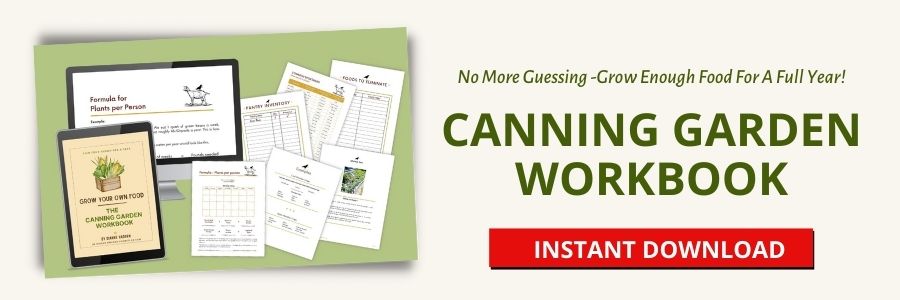Hidden Springs Homestead may earn a commission for purchases made after clicking links on this page. Learn More.
Learning how to grow bell peppers can seem a bit challenging, but YOU CAN DO IT! Bell Peppers are a warm-season vegetable that grows rather slowly, but the rewards are delicious.
They are members of the Solanaceae family. They can be red, yellow, green, orange, and even purple. So just a gorgeous rainbow of colors.
The plants themselves in addition to the actual fruits, are very attractive and would look great in an edible landscape.
So what is the best way to grow bell peppers? Here is how to grow them in your victory or home garden.
When to Plant Bell Pepper Seeds
Unless you have a really long growing season, bell peppers seeds will need to be started indoors 8-9 weeks prior to the last frost date in your area.
Peppers require 60-90 days to grow, so getting them started indoors will be very helpful to your success.
How to Plant Bell Peppers Seeds
This seed-starting system will walk you through getting started with more precise details. For lighting, take a look at building your own grow light system.
Pepper seeds are really small, so they only need to be planted at a depth of 1/4 inch deep.
Using heat mats, keep soil temperatures at a consistent 80-85°F (27-29°C), and seeds will germinate in 6-10 days. But I’ll be honest and say I’ve had them take as long as 14-15 days to germinate, so be patient with them. This was before I bought heat mats.
Remember, growing bell peppers is not really easy, but you can do it! And by doing so, you can save lots of money on the family budget.
Use your basic seed starting system, plant 2-3 seeds into each container, and keep consistently warm and moist. Once seeds germinate, keep the soil moist.
If space is a problem, and you don’t have a grow light system, place seed containers in a sunny window to give them as much light as possible.
Once they have grown 2-3 true leaves, transplant them into larger containers and continue to keep them warm and moist.

RELATED: Even if you’ve never gardened before, this Vegetable Gardening for Beginners Ultimate Guide is for you! Learn everything you need to know from over 60 resources, all in one place, to be a successful gardener, including improving soil, cover crops, warm and cool season crops, organic amendments, fertilizing, watering, and so much more.
How to Transplant Bell Pepper Seedlings
Bell peppers seedlings should not be planted outdoors until nighttime temperatures are consistently over 70°F (21°C).
Plant seedlings 24 inches apart, so they have plenty of room to stretch and grow over the summer months. But still close enough to protect each other from the hot scorching sun.
RELATED: Garden Mapping: How to Plan and Organize Your Vegetable Garden – Spacing, Rotation, Trellising, and more!
Don’t plant them any deeper than they are in seedling containers. Otherwise, they are more susceptible to disease and rot. They need full sun to grow strong and healthy.
Bell peppers will grow faster in healthy garden soil with a pH range of 5.5-7.0 pH. If your pH level is a bit off, here are some simple natural ways to improve it.
To find out your soil’s pH, check with your local extension agency to obtain a soil test. The cost is around $10 and well worth it, so you are not “guessing” the health of your garden soil.

RELATED: Take the guesswork out! Use the easy formula worksheets in The Canning Garden Workbook (printable) to figure out how much to plant, for canning, to feed your family for a full year!
How to Fertilize Bell Pepper Plants
Peppers will benefit most from organic composted manure or fish emulsion as a fertilizer.
7-10 days prior to planting, feed garden soil with good organic aged compost and/or manure. The soil should also drain well.
Over-fertilizing will cause excessive leaf growth, which leads to reduced fruit production. So follow the instructions on the container carefully.
Fertilize a second time after they set fruit. This will help keep them strong and healthy.

NOTE: Bell pepper plants grow to be around 3 feet tall and will need some support for standing. Use garden stakes and tie the plant to them or basic tomato cages work well too.
Just give them some support so they can continue to grow tall and strong without bending over.
How to Water Bell Peppers
Water is crucial to growing large bell peppers. The soil should be kept evenly moist using a mulch or straw.
Remember, they are sun-loving summer plants, so watering daily may be necessary to set lots of large fruit.
Uneven watering will reduce the size and number of peppers. They will need 1-2 inches of water per week.
When to Harvest Bell Peppers
The best part of growing peppers is harvesting!
Feel free to leave them on the vines as long as you like. Let them get as large as you wish them to be. The longer they hang on the plant, the sweeter they become!
If you are growing a pepper variety that is a color than green – they are not truly mature until they change color.
But allowing the fruit to “mature” on the plant may slow production. Plants will continue to produce fruits as long as it is harvested or fall frost kills them.
To harvest or remove from the plant, carefully use a small sharp knife and cut the fruit stem to be 1-2 inches long from the mother plant.

Companions for Peppers:
- Onions
- Green Peas
- Tomatoes
- Carrots
- Eggplant
How To Store Peppers
Bell peppers can be stored fresh in the refrigerator for up to 10 days in an air-tight container or bag.
They can also be easily frozen for even longer storage. Interestingly enough, peppers can even be dried.

So even though learning how to grow bell peppers might be a bit slow to get the seeds to germinate, once they do, they are pretty much like growing any other vegetable. They just take a while to set fruit. But so worth the wait.
Related: Learn more about freezing with my Quick Start Guide to freezing Food at Home
Will you be growing bell peppers in your home garden this season?

Easy Recipes Using Peppers
- Kielbasa with Peppers and Onions
- Tangy to Fiery Perfect Pickle Recipe
- Cheese Mexican Skillet Casserole
- Pan-Fried Cube Steaks
- Pizza Casserole Recipe
More Gardening Tips

Connect with Hidden Springs Homestead!
Be sure to follow me on social media so you never miss a post!

Dianne Hadorn is the owner of Hidden Springs Homestead nestled in the hills of East Tennessee. She is a Master Gardener and enjoys helping others learn how to grow and preserve their own food and sharing tips for living a more self-sufficient lifestyle.

I’m actually trying to grow potato this year.
Hi Veronica,
This is great! I’m glad you are growing them. If I can help, please let me know. In the meantime, did you see this post from the site?
https://www.hiddenspringshomestead.com/growing-potatoes-everything-to-know/
Good luck – they will taste so much better than those bought at the grocery.
Happy Gardening
Dianne